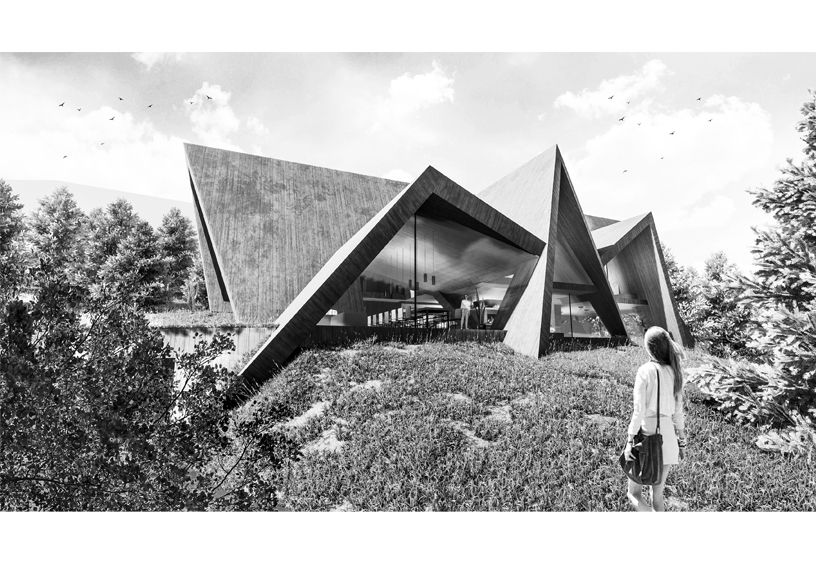

The project, a villa for three generations, designed by ‘noa* network of architecture’ is a reinterpretation of the iconic A-frame typology turning it into a sophisticated sequence of private and communal spaces.
Surrounded by the snow-capped peaks of the Rocky Mountains and extensive pine forests, the project is a holiday home nestled in the majestic nature of Colorado. Here, it is common to come across the archetypal American holiday home, the so-called ‘A-Frame’. This typology, which has become a symbol of weekend getaways from the city, featuring steeply pitched roofs that replace the walls entirely and provide ideal weather protection in snowy regions. The architects took a personal interpretation of the distinctive clean geometry of the A-frame and created a cosy refuge where one can come together as a family and reconnect with nature.
From the outset, the challenge of the functional programme turned out to be the coexistence of three different generations in what visually had to be a single volume. The interior layout of the spaces had to combine common areas with independent privacy zones for each of the families. In a perfect convergence between the client’s needs and architecture, the team of designers decided to adopt the typology of the triangular house in a more complex interplay of volumes, creating a multifaceted spatiality with an increasing level of privacy on the higher floors.
“We have implemented the clear geometry and outward openness typical of the A-frame, but at the same time, we have accommodated smaller, unexpected, but still very comfortable spaces within the larger volume. It’s a space concept similar to a matryoshka system,” explained Andreas Profanter, noa* partner and project leader.
The result is a 30m-long triangular prism intersected at several points by volumes of the same geometry. The architecture, which in its articulated structure is perceived as a single body, houses a completely independent private villa for the client couple and a family villa for their children and grandchildren.
The entrance door on the east side of the house leads to a first stairwell. From here, one can access three areas: The basement with parking spaces and cellar rooms; The client couple’s private villa; and the family villa with a large communal living area. The ground floor of the private villa accommodates a living room, a freestanding stairway, a kitchen with a cooking island and two offices overlooking the inner courtyard, where the barbecue area is set. The heart of the family villa is the large fireplace on the ground floor, which serves as a focal point between the spacious kitchen to the east and the generous living room to the west. The representative dining room with double room height adjoins the kitchen to the north. The relationship with the surrounding landscape is constantly being pursued: large glass façades on all house fronts provide ever-changing perspectives. The boundaries between outside and inside are blurred throughout the building, as in the living area, where part of the rock is integrated into the space.
On the upper floor of the villa, there are five bedrooms aligned with the roof’s ridges. The rooms have an open plan design, and the conventional division of space into sleeping area and bathroom has been fluidly reimagined, with freestanding washbasins and bathtubs. To allow the little ones to carve out a space for themselves, play areas have been created on the attic floor. These are directly accessible from the parents’ rooms.
“In agreement with the clients, we designed each room with maximum autonomy and comfort. Fluid spaces, double heights and a few surprise elements. Like, for example, the children’s playrooms, that can be reached via stairs hidden in the parents’ rooms,” said architect Andrea Dal Negro, who was part of the villa’s design team.
Once again, the architecture and interiors of the South Tyrolean design studio conveyed the expressive power and refined relationship with nature common to all projects designed by the architects. It is a project where intimacy and togetherness meet and where one can find itself in a unique symbiosis with the surrounding landscape.
Rendering: ©Dima Visualization
Factfile-
Project: Colorado Villa
Architects: noa* network of architecture
Typology: Living
Interior Design: noa* network of architecture
Surface area: 600sq m
The architectural landscape of Rajasthan is steeped in a rich tradition of historic masonry, reflecting…
Are you a corporate employee spending 10+ hours in an ordinary cubicle that's fused in…
Modern Indian homes are no longer bound by their physical vicinity. They have outgrown our…
Häcker Kitchens, a brand synonymous with quality and innovation, has a rich legacy that spans…
In this home designed by Sonal R Mutha and Aniketh Bafna, founders and principal designers…
Essentia Home’s journey in redefining luxury interiors took a bold new step as it opened…